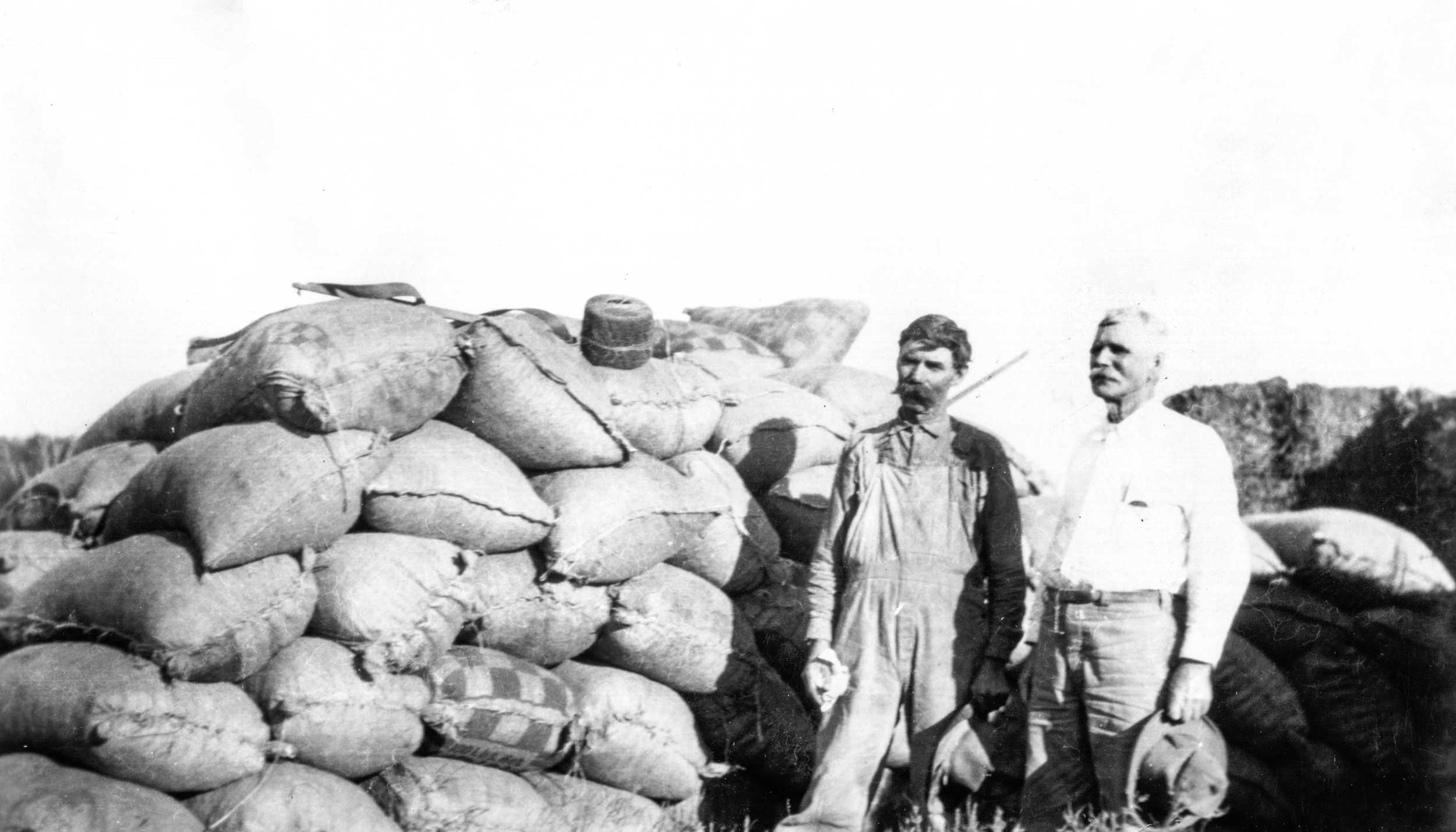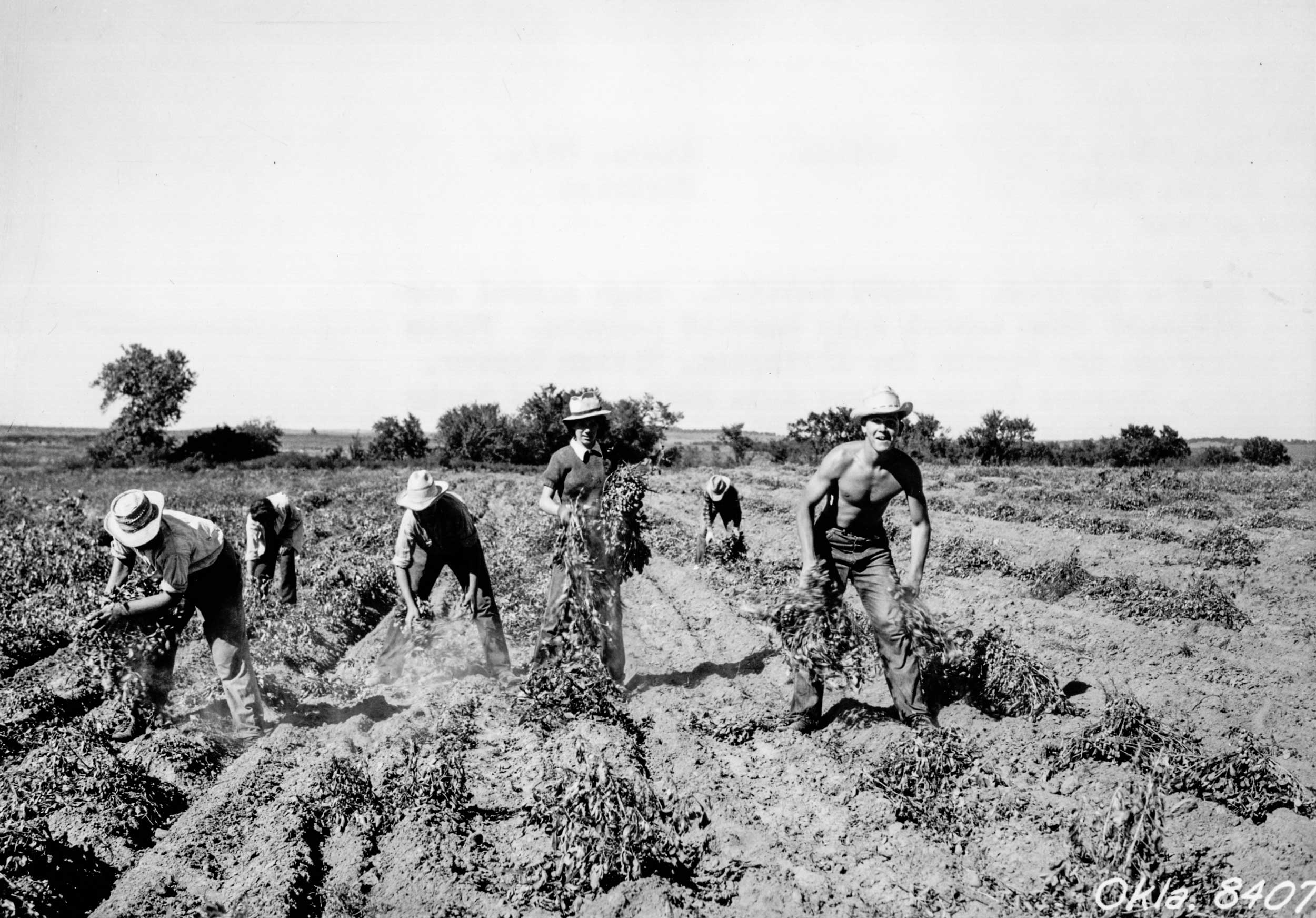PEANUTS.
Also known as goobers and ground peas, peanuts became a commercial crop after the Civil War. Before then, the legume was a regional food in the South. The peanut not only provided nourishment to humans, but also was used to fatten livestock, especially hogs. In the twentieth century, after George Washington Carver developed more than three hundred uses for it, the peanut gained importance. In the United States the crop is used for roasted peanuts, peanut butter, confectionary products, oil, and animal feed.
The Five Tribes brought peanuts to the Indian Territory, planting them in small gardens. After the general settlement of Oklahoma Territory, residents also planted parcels of the nuts, often selling or trading them to neighbors. Some entrepreneurs cultivated larger crops, marketing the product in town or shipping it via the railroads. In 1891 a farmer near Norman on the banks of the Canadian River grew three hundred bushels, increasing the yield to twenty-five hundred the next year. In 1898 three peanut farmers near Guthrie purchased a "peanut thresher, polisher, and grader" to enlarge their manageable acreage. That year one of the farmers, Jefferson Bowen, planted thirty-five acres, harvesting forty to eighty bushels per acre. Another of the partners, Sam Atherton, threshed thirty thousand bushels in 1900. At the turn of the twentieth century newspapers began to advocate peanut farming and published instructional articles on the subject.
Agricultural agents affiliated with Oklahoma A&M College (now Oklahoma State University) and the Agricultural Experiment Station also touted peanuts as a viable alternative to cotton. At 1907 statehood the largest concentration of peanut production occurred in Comanche (170 acres and 198,398 pounds), Stephens (24 and 41,100), Caddo (30 and 28,013), Texas (28 and 22,531), Johnston (20 and 14,706), Beaver (308 acres and 14,029 pounds), Roger Mills (26 and 13,721), Jackson (317 and 10,216), and Oklahoma (129 and 4,806) counties. In the early 1920s, as agriculturalists focused on diversifying fields, many southeastern Oklahoma farmers shifted to peanuts. In 1922 Bryan County residents raised 120,000 bushels, and the county continued as one of Oklahoma's leading producers. In 1923 the state cultivated 4,950,000 pounds that were valued at $317,000. By 1927 Oklahoma produced 13,300,000 pounds, and the next year the figure climbed to 24,050,000 pounds. This encouraged related businesses and, for example, in 1922 a peanut butter manufacturing plant opened in Sand Springs.
The hard economic times of the 1930s impacted the industry. The average price per pound of the nut remained near or above five cents until 1930 when it fell to 4.3 cents. As the Great Depression devastated Oklahoma's economy, the value declined to 1.6 cents a pound in 1932, and farmers cultivated only 15,950,000 pounds on 60,000 acres and interplanted another 2,000 acres with other crops. By 1937 there were only about 34,000 acres of peanuts, with the overall pounds produced equaling 11,875,000. In 1934 the federal government began to regulate the industry through various methods, including a quota system. By 1941 production had climbed to 45,100,000 pounds. As the industry expanded in the 1920s several towns constructed peanut processing plants, and more were built after the Depression in towns including Muskogee, Bristow, Durant (three), Hugo, Shawnee, Okmulgee, Oklahoma City, and Konawa. After World War II ended, Oklahoma A&M established a peanut research station at Stratford.
Of the four basic types of peanuts, Oklahomans mainly raised Spanish and Runners (Virginia and Valencia nuts were the other varieties). In 1945 Bryan County led Oklahoma in number of acres planted (30,100) and in production (14,543,000 pounds). The counties of Caddo (20,000 acres and 8,090,000 pounds), Hughes (16,000 and 8,194,000), Pittsburg (9,600 and 4,465,000), and Seminole (9,500 and 4,250,000) followed. By 1965 Caddo County, with 31,710 acres and 86,802,000 pounds, led the state in production, and was followed by Bryan (21,310 and 17,363,600), Hughes (15,940 and 22,608,000), Love (5,470 and 7,357,500), Pottawatomie (3,850 and 6,096,000), and Johnston (4,360 and 6,090,000) counties. That year the state produced 207,360,000 pounds. Also in 1965 the legislature created the Oklahoma Peanut Commission to promote the industry.
Oklahoma has consistently been one of America's top-ten peanut producers, usually behind Georgia, Texas, Alabama, North Carolina, and Virginia. In 1987 the state's 109,592,633 pounds of peanuts ranked it seventh, and in 1992 the 203,107,412 moved it to sixth. In 1987 the cash receipts for Oklahoma's peanut crop ranked third among Oklahoma's agricultural products, behind wheat and cotton. In 1997 Oklahoma fell to seventh in the nation's production at 163,572,035. Changes in federal subsidy programs in 1981 and 2002 led to a decline in yield, with a figure of 144,450,348 pounds in 2002 (ranked sixth in the nation), falling to an estimated one hundred million pounds in 2004.
Learn More
"Agriculture: Peanuts," Vertical File, Research Division, Oklahoma Historical Society, Oklahoma City.
Donald E. Green, A History of the Oklahoma State University Division of Agriculture (Stillwater: Oklahoma State University, 1990).
F. Roy Johnson, The Peanut Story (Murfreesboro, N.C.: Johnson Publishing Co., 1964).
Percival Perry, "Peanuts," in Encyclopedia of Southern Culture, ed. Charles Reagan Wilson and William Ferris (Chapel Hill: University of North Carolina Press, 1989).
Huber Self, "The Peanut Industry in Oklahoma" (M.S. thesis, Oklahoma A&M College, 1947).
Citation
The following (as per The Chicago Manual of Style, 17th edition) is the preferred citation for articles:
Larry O'Dell, “Peanuts,” The Encyclopedia of Oklahoma History and Culture, https://www.okhistory.org/publications/enc/entry?entry=PE002.
Published January 15, 2010
© Oklahoma Historical Society



